Environmental and Occupational Health: A Chlordane Toxicity Case Study
VerifiedAdded on 2023/01/11
|14
|3516
|51
Case Study
AI Summary
This case study delves into the environmental and occupational health hazards associated with chlordane, a chlorinated cyclodiene insecticide and pesticide. It examines various aspects of chlordane exposure, including inhalation, skin absorption, and ingestion, and their resulting toxic effects. The case study presents real-world scenarios, such as exposure in residential settings and occupational environments, and analyzes the symptoms and health complications associated with chlordane poisoning. It also explores management strategies, including mitigation measures like sealing areas to prevent chlordane release and long-term solutions like removing potential sources. The study highlights the importance of understanding chlordane's properties, exposure routes, and the need for preventive measures to safeguard public health and worker safety. The assignment covers the historical context of chlordane usage, the relationship between exposure levels and health outcomes, and the strategies employed by manufacturers to minimize environmental hazards.

Running head: TOXICOLOGY 1
Case Study on Chlordane Toxicity
Student
Institutional affiliation
Case Study on Chlordane Toxicity
Student
Institutional affiliation
Paraphrase This Document
Need a fresh take? Get an instant paraphrase of this document with our AI Paraphraser

TOXICOLOGY 2
Table of Contents
Introduction......................................................................................................................................3
Background Information..................................................................................................................3
Chlordane Exposure........................................................................................................................4
Chlordane Toxicity......................................................................................................................4
Occupational Exposures...............................................................................................................8
Management of Chlordane Exposure...........................................................................................9
Conclusion.....................................................................................................................................11
Table of Contents
Introduction......................................................................................................................................3
Background Information..................................................................................................................3
Chlordane Exposure........................................................................................................................4
Chlordane Toxicity......................................................................................................................4
Occupational Exposures...............................................................................................................8
Management of Chlordane Exposure...........................................................................................9
Conclusion.....................................................................................................................................11
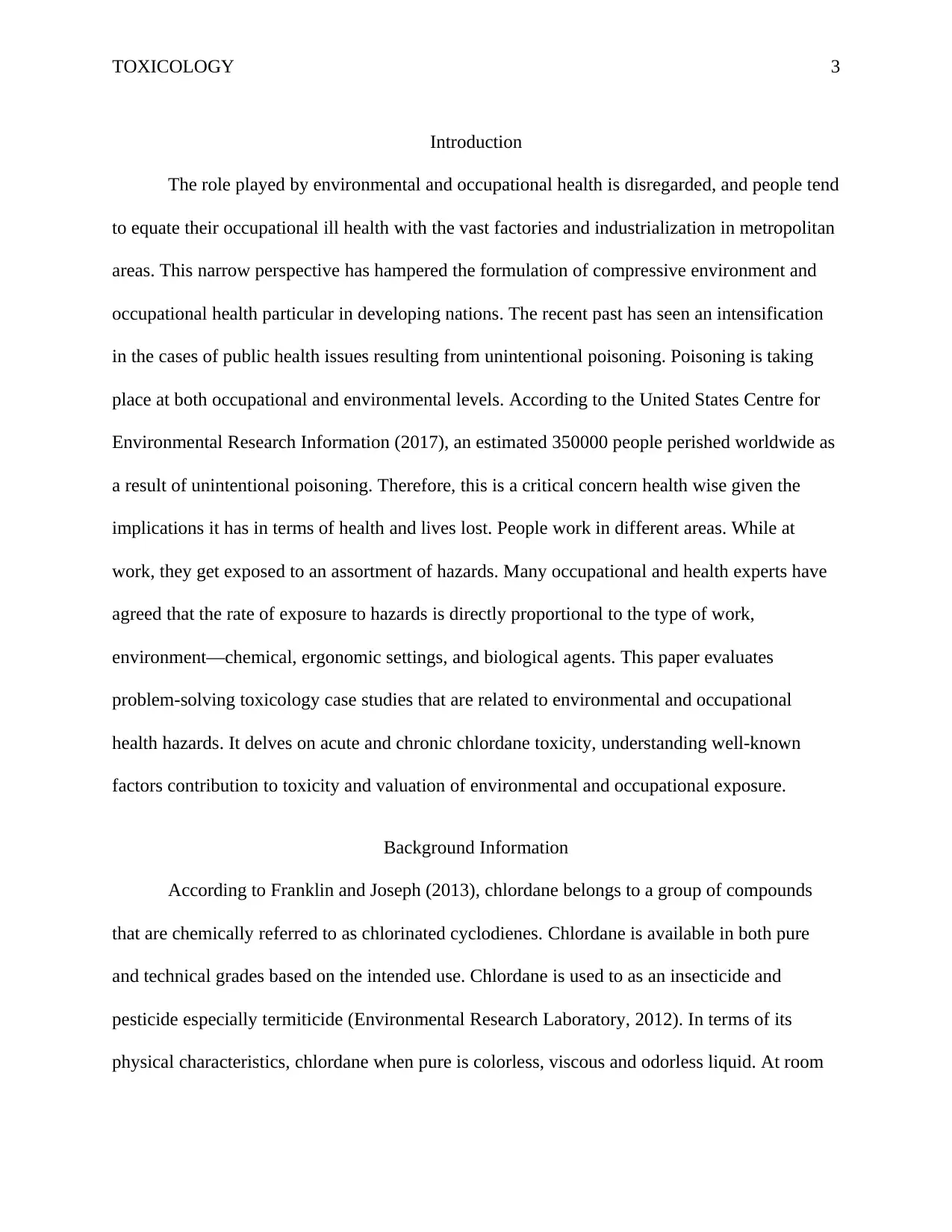
TOXICOLOGY 3
Introduction
The role played by environmental and occupational health is disregarded, and people tend
to equate their occupational ill health with the vast factories and industrialization in metropolitan
areas. This narrow perspective has hampered the formulation of compressive environment and
occupational health particular in developing nations. The recent past has seen an intensification
in the cases of public health issues resulting from unintentional poisoning. Poisoning is taking
place at both occupational and environmental levels. According to the United States Centre for
Environmental Research Information (2017), an estimated 350000 people perished worldwide as
a result of unintentional poisoning. Therefore, this is a critical concern health wise given the
implications it has in terms of health and lives lost. People work in different areas. While at
work, they get exposed to an assortment of hazards. Many occupational and health experts have
agreed that the rate of exposure to hazards is directly proportional to the type of work,
environment—chemical, ergonomic settings, and biological agents. This paper evaluates
problem-solving toxicology case studies that are related to environmental and occupational
health hazards. It delves on acute and chronic chlordane toxicity, understanding well-known
factors contribution to toxicity and valuation of environmental and occupational exposure.
Background Information
According to Franklin and Joseph (2013), chlordane belongs to a group of compounds
that are chemically referred to as chlorinated cyclodienes. Chlordane is available in both pure
and technical grades based on the intended use. Chlordane is used to as an insecticide and
pesticide especially termiticide (Environmental Research Laboratory, 2012). In terms of its
physical characteristics, chlordane when pure is colorless, viscous and odorless liquid. At room
Introduction
The role played by environmental and occupational health is disregarded, and people tend
to equate their occupational ill health with the vast factories and industrialization in metropolitan
areas. This narrow perspective has hampered the formulation of compressive environment and
occupational health particular in developing nations. The recent past has seen an intensification
in the cases of public health issues resulting from unintentional poisoning. Poisoning is taking
place at both occupational and environmental levels. According to the United States Centre for
Environmental Research Information (2017), an estimated 350000 people perished worldwide as
a result of unintentional poisoning. Therefore, this is a critical concern health wise given the
implications it has in terms of health and lives lost. People work in different areas. While at
work, they get exposed to an assortment of hazards. Many occupational and health experts have
agreed that the rate of exposure to hazards is directly proportional to the type of work,
environment—chemical, ergonomic settings, and biological agents. This paper evaluates
problem-solving toxicology case studies that are related to environmental and occupational
health hazards. It delves on acute and chronic chlordane toxicity, understanding well-known
factors contribution to toxicity and valuation of environmental and occupational exposure.
Background Information
According to Franklin and Joseph (2013), chlordane belongs to a group of compounds
that are chemically referred to as chlorinated cyclodienes. Chlordane is available in both pure
and technical grades based on the intended use. Chlordane is used to as an insecticide and
pesticide especially termiticide (Environmental Research Laboratory, 2012). In terms of its
physical characteristics, chlordane when pure is colorless, viscous and odorless liquid. At room
⊘ This is a preview!⊘
Do you want full access?
Subscribe today to unlock all pages.

Trusted by 1+ million students worldwide

TOXICOLOGY 4
temperature (25 degrees Celsius) chlordane is exceedingly soluble in most carbon-based solvents
such as hydrocarbons of petroleum (Clement International Corporation & United States, 2015).
Emulsifiable concentrate of chlordane—commonly known as technical chlordane—is
sold for use in water as suspension which can be spayed. Chlordane is also available in powder
form which is normally adulterated with mineral specks of dust such as talc (Clement
International Corporation., & United States, 2015). Chlordane was first produced in 1947
commercially for pesticide manufacturing.
Chlordane has a variety of uses, particularly in insect and pest control. Based on Franklin
and Joseph (2011), Chlordane is an active constituent in most household and garden pesticides.
The chemical has been mainly used in the manufacture of chemicals that are used in the
eradication of termites around the foundations of houses. Additionally, chlordane is used to
control insects and pests in corn fields (Environmental Research Laboratory, 2012).
Chlordane Exposure
Most of the people who get exposed to chlordane say it happens via active inhalation.
Odorless is one of the physical characteristics of chlordane. Chlordane has low vapor pressure at
room temperatures (David & Jagdish, 2017). However, in hot conditions chlordane volatilizes.
Give it odorless property most people get exposed to it without adequate warning. Inhalation also
happens when a chlordane solvent vaporizes. Chlordane is absorbed rapidly via the skin leading
to systematic toxicity. This is because the skin has oils that aid in absorption. Direct ingestion of
chlordane has acute toxic effects, among them death (Levy, 2014).
Chlordane Toxicity
temperature (25 degrees Celsius) chlordane is exceedingly soluble in most carbon-based solvents
such as hydrocarbons of petroleum (Clement International Corporation & United States, 2015).
Emulsifiable concentrate of chlordane—commonly known as technical chlordane—is
sold for use in water as suspension which can be spayed. Chlordane is also available in powder
form which is normally adulterated with mineral specks of dust such as talc (Clement
International Corporation., & United States, 2015). Chlordane was first produced in 1947
commercially for pesticide manufacturing.
Chlordane has a variety of uses, particularly in insect and pest control. Based on Franklin
and Joseph (2011), Chlordane is an active constituent in most household and garden pesticides.
The chemical has been mainly used in the manufacture of chemicals that are used in the
eradication of termites around the foundations of houses. Additionally, chlordane is used to
control insects and pests in corn fields (Environmental Research Laboratory, 2012).
Chlordane Exposure
Most of the people who get exposed to chlordane say it happens via active inhalation.
Odorless is one of the physical characteristics of chlordane. Chlordane has low vapor pressure at
room temperatures (David & Jagdish, 2017). However, in hot conditions chlordane volatilizes.
Give it odorless property most people get exposed to it without adequate warning. Inhalation also
happens when a chlordane solvent vaporizes. Chlordane is absorbed rapidly via the skin leading
to systematic toxicity. This is because the skin has oils that aid in absorption. Direct ingestion of
chlordane has acute toxic effects, among them death (Levy, 2014).
Chlordane Toxicity
Paraphrase This Document
Need a fresh take? Get an instant paraphrase of this document with our AI Paraphraser
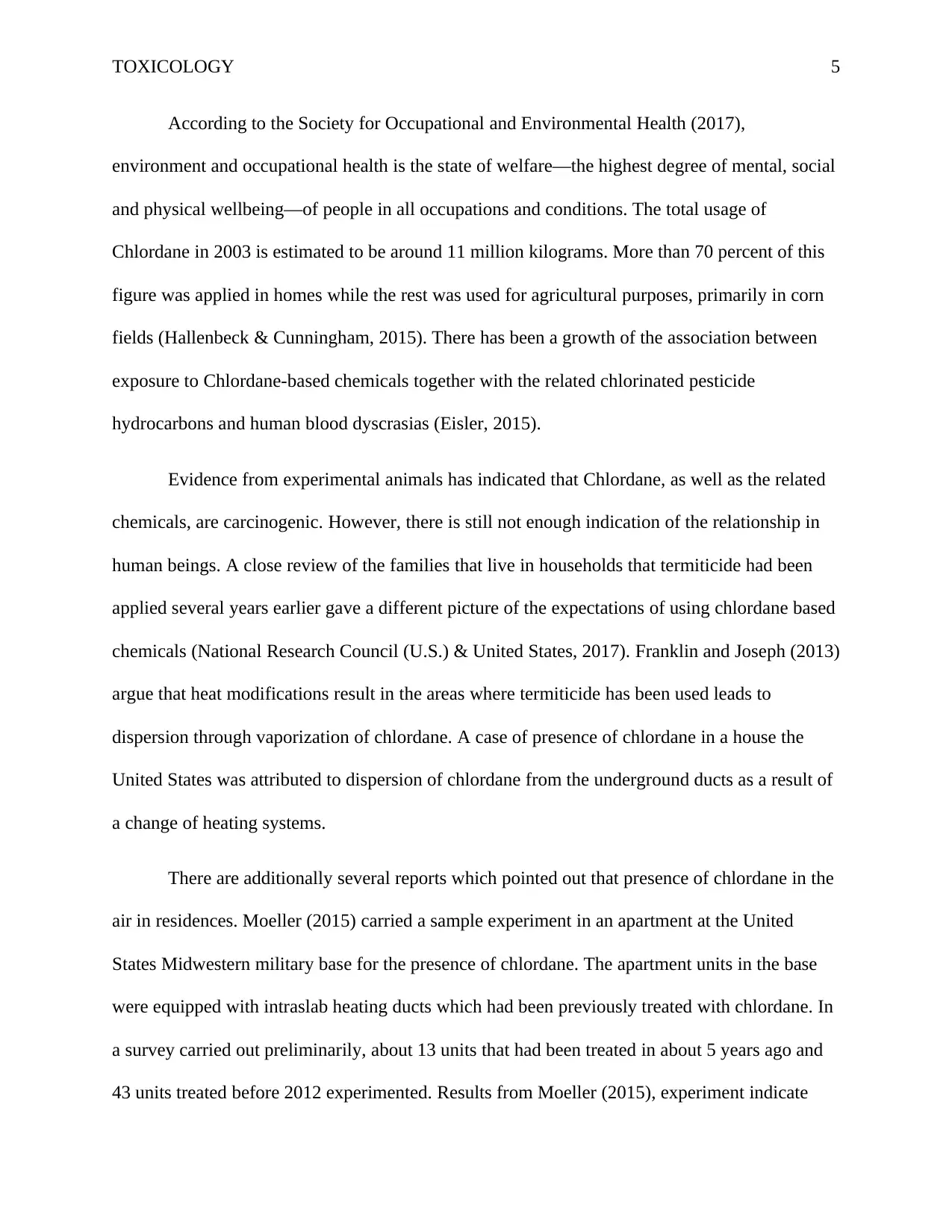
TOXICOLOGY 5
According to the Society for Occupational and Environmental Health (2017),
environment and occupational health is the state of welfare—the highest degree of mental, social
and physical wellbeing—of people in all occupations and conditions. The total usage of
Chlordane in 2003 is estimated to be around 11 million kilograms. More than 70 percent of this
figure was applied in homes while the rest was used for agricultural purposes, primarily in corn
fields (Hallenbeck & Cunningham, 2015). There has been a growth of the association between
exposure to Chlordane-based chemicals together with the related chlorinated pesticide
hydrocarbons and human blood dyscrasias (Eisler, 2015).
Evidence from experimental animals has indicated that Chlordane, as well as the related
chemicals, are carcinogenic. However, there is still not enough indication of the relationship in
human beings. A close review of the families that live in households that termiticide had been
applied several years earlier gave a different picture of the expectations of using chlordane based
chemicals (National Research Council (U.S.) & United States, 2017). Franklin and Joseph (2013)
argue that heat modifications result in the areas where termiticide has been used leads to
dispersion through vaporization of chlordane. A case of presence of chlordane in a house the
United States was attributed to dispersion of chlordane from the underground ducts as a result of
a change of heating systems.
There are additionally several reports which pointed out that presence of chlordane in the
air in residences. Moeller (2015) carried a sample experiment in an apartment at the United
States Midwestern military base for the presence of chlordane. The apartment units in the base
were equipped with intraslab heating ducts which had been previously treated with chlordane. In
a survey carried out preliminarily, about 13 units that had been treated in about 5 years ago and
43 units treated before 2012 experimented. Results from Moeller (2015), experiment indicate
According to the Society for Occupational and Environmental Health (2017),
environment and occupational health is the state of welfare—the highest degree of mental, social
and physical wellbeing—of people in all occupations and conditions. The total usage of
Chlordane in 2003 is estimated to be around 11 million kilograms. More than 70 percent of this
figure was applied in homes while the rest was used for agricultural purposes, primarily in corn
fields (Hallenbeck & Cunningham, 2015). There has been a growth of the association between
exposure to Chlordane-based chemicals together with the related chlorinated pesticide
hydrocarbons and human blood dyscrasias (Eisler, 2015).
Evidence from experimental animals has indicated that Chlordane, as well as the related
chemicals, are carcinogenic. However, there is still not enough indication of the relationship in
human beings. A close review of the families that live in households that termiticide had been
applied several years earlier gave a different picture of the expectations of using chlordane based
chemicals (National Research Council (U.S.) & United States, 2017). Franklin and Joseph (2013)
argue that heat modifications result in the areas where termiticide has been used leads to
dispersion through vaporization of chlordane. A case of presence of chlordane in a house the
United States was attributed to dispersion of chlordane from the underground ducts as a result of
a change of heating systems.
There are additionally several reports which pointed out that presence of chlordane in the
air in residences. Moeller (2015) carried a sample experiment in an apartment at the United
States Midwestern military base for the presence of chlordane. The apartment units in the base
were equipped with intraslab heating ducts which had been previously treated with chlordane. In
a survey carried out preliminarily, about 13 units that had been treated in about 5 years ago and
43 units treated before 2012 experimented. Results from Moeller (2015), experiment indicate
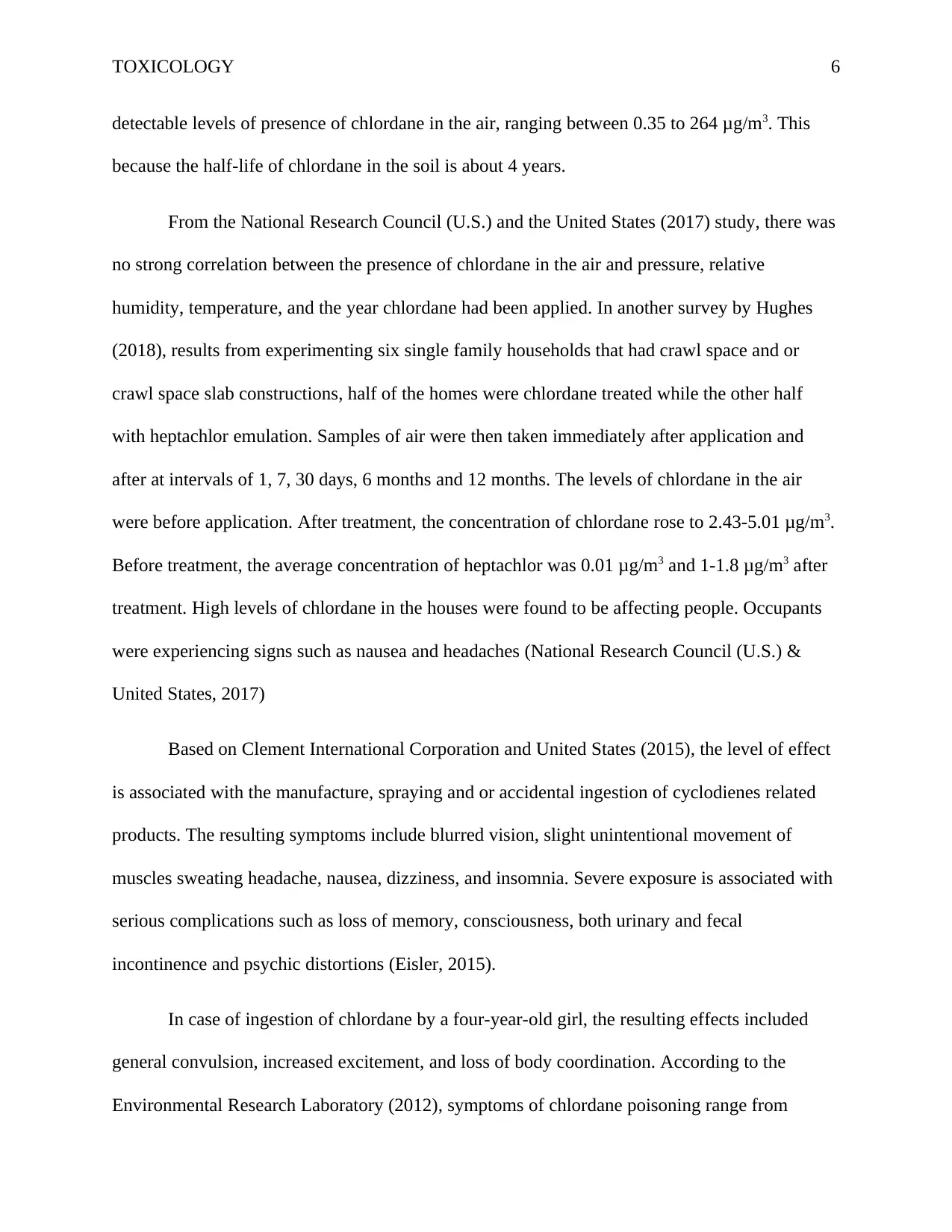
TOXICOLOGY 6
detectable levels of presence of chlordane in the air, ranging between 0.35 to 264 μg/m3. This
because the half-life of chlordane in the soil is about 4 years.
From the National Research Council (U.S.) and the United States (2017) study, there was
no strong correlation between the presence of chlordane in the air and pressure, relative
humidity, temperature, and the year chlordane had been applied. In another survey by Hughes
(2018), results from experimenting six single family households that had crawl space and or
crawl space slab constructions, half of the homes were chlordane treated while the other half
with heptachlor emulation. Samples of air were then taken immediately after application and
after at intervals of 1, 7, 30 days, 6 months and 12 months. The levels of chlordane in the air
were before application. After treatment, the concentration of chlordane rose to 2.43-5.01 μg/m3.
Before treatment, the average concentration of heptachlor was 0.01 μg/m3 and 1-1.8 μg/m3 after
treatment. High levels of chlordane in the houses were found to be affecting people. Occupants
were experiencing signs such as nausea and headaches (National Research Council (U.S.) &
United States, 2017)
Based on Clement International Corporation and United States (2015), the level of effect
is associated with the manufacture, spraying and or accidental ingestion of cyclodienes related
products. The resulting symptoms include blurred vision, slight unintentional movement of
muscles sweating headache, nausea, dizziness, and insomnia. Severe exposure is associated with
serious complications such as loss of memory, consciousness, both urinary and fecal
incontinence and psychic distortions (Eisler, 2015).
In case of ingestion of chlordane by a four-year-old girl, the resulting effects included
general convulsion, increased excitement, and loss of body coordination. According to the
Environmental Research Laboratory (2012), symptoms of chlordane poisoning range from
detectable levels of presence of chlordane in the air, ranging between 0.35 to 264 μg/m3. This
because the half-life of chlordane in the soil is about 4 years.
From the National Research Council (U.S.) and the United States (2017) study, there was
no strong correlation between the presence of chlordane in the air and pressure, relative
humidity, temperature, and the year chlordane had been applied. In another survey by Hughes
(2018), results from experimenting six single family households that had crawl space and or
crawl space slab constructions, half of the homes were chlordane treated while the other half
with heptachlor emulation. Samples of air were then taken immediately after application and
after at intervals of 1, 7, 30 days, 6 months and 12 months. The levels of chlordane in the air
were before application. After treatment, the concentration of chlordane rose to 2.43-5.01 μg/m3.
Before treatment, the average concentration of heptachlor was 0.01 μg/m3 and 1-1.8 μg/m3 after
treatment. High levels of chlordane in the houses were found to be affecting people. Occupants
were experiencing signs such as nausea and headaches (National Research Council (U.S.) &
United States, 2017)
Based on Clement International Corporation and United States (2015), the level of effect
is associated with the manufacture, spraying and or accidental ingestion of cyclodienes related
products. The resulting symptoms include blurred vision, slight unintentional movement of
muscles sweating headache, nausea, dizziness, and insomnia. Severe exposure is associated with
serious complications such as loss of memory, consciousness, both urinary and fecal
incontinence and psychic distortions (Eisler, 2015).
In case of ingestion of chlordane by a four-year-old girl, the resulting effects included
general convulsion, increased excitement, and loss of body coordination. According to the
Environmental Research Laboratory (2012), symptoms of chlordane poisoning range from
⊘ This is a preview!⊘
Do you want full access?
Subscribe today to unlock all pages.

Trusted by 1+ million students worldwide
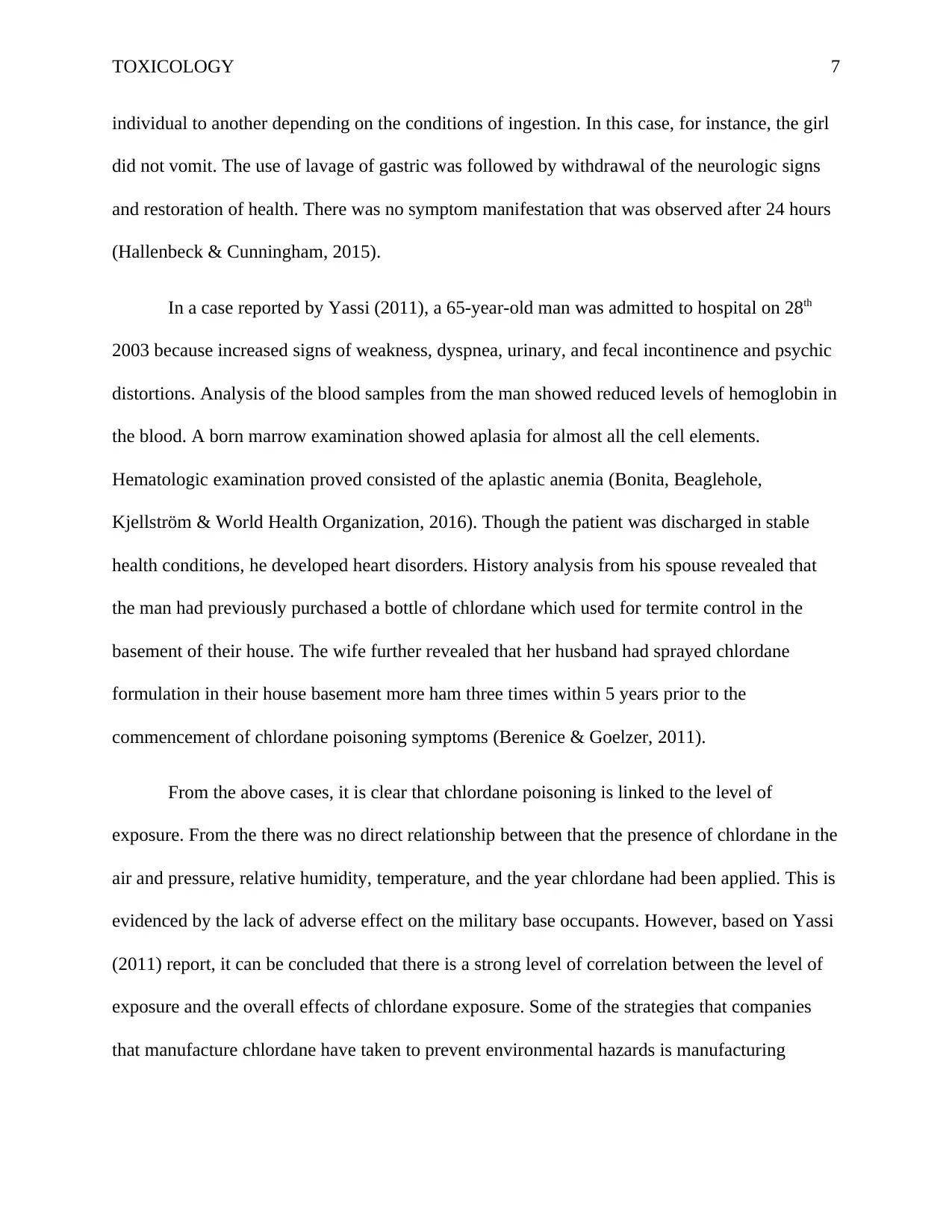
TOXICOLOGY 7
individual to another depending on the conditions of ingestion. In this case, for instance, the girl
did not vomit. The use of lavage of gastric was followed by withdrawal of the neurologic signs
and restoration of health. There was no symptom manifestation that was observed after 24 hours
(Hallenbeck & Cunningham, 2015).
In a case reported by Yassi (2011), a 65-year-old man was admitted to hospital on 28th
2003 because increased signs of weakness, dyspnea, urinary, and fecal incontinence and psychic
distortions. Analysis of the blood samples from the man showed reduced levels of hemoglobin in
the blood. A born marrow examination showed aplasia for almost all the cell elements.
Hematologic examination proved consisted of the aplastic anemia (Bonita, Beaglehole,
Kjellström & World Health Organization, 2016). Though the patient was discharged in stable
health conditions, he developed heart disorders. History analysis from his spouse revealed that
the man had previously purchased a bottle of chlordane which used for termite control in the
basement of their house. The wife further revealed that her husband had sprayed chlordane
formulation in their house basement more ham three times within 5 years prior to the
commencement of chlordane poisoning symptoms (Berenice & Goelzer, 2011).
From the above cases, it is clear that chlordane poisoning is linked to the level of
exposure. From the there was no direct relationship between that the presence of chlordane in the
air and pressure, relative humidity, temperature, and the year chlordane had been applied. This is
evidenced by the lack of adverse effect on the military base occupants. However, based on Yassi
(2011) report, it can be concluded that there is a strong level of correlation between the level of
exposure and the overall effects of chlordane exposure. Some of the strategies that companies
that manufacture chlordane have taken to prevent environmental hazards is manufacturing
individual to another depending on the conditions of ingestion. In this case, for instance, the girl
did not vomit. The use of lavage of gastric was followed by withdrawal of the neurologic signs
and restoration of health. There was no symptom manifestation that was observed after 24 hours
(Hallenbeck & Cunningham, 2015).
In a case reported by Yassi (2011), a 65-year-old man was admitted to hospital on 28th
2003 because increased signs of weakness, dyspnea, urinary, and fecal incontinence and psychic
distortions. Analysis of the blood samples from the man showed reduced levels of hemoglobin in
the blood. A born marrow examination showed aplasia for almost all the cell elements.
Hematologic examination proved consisted of the aplastic anemia (Bonita, Beaglehole,
Kjellström & World Health Organization, 2016). Though the patient was discharged in stable
health conditions, he developed heart disorders. History analysis from his spouse revealed that
the man had previously purchased a bottle of chlordane which used for termite control in the
basement of their house. The wife further revealed that her husband had sprayed chlordane
formulation in their house basement more ham three times within 5 years prior to the
commencement of chlordane poisoning symptoms (Berenice & Goelzer, 2011).
From the above cases, it is clear that chlordane poisoning is linked to the level of
exposure. From the there was no direct relationship between that the presence of chlordane in the
air and pressure, relative humidity, temperature, and the year chlordane had been applied. This is
evidenced by the lack of adverse effect on the military base occupants. However, based on Yassi
(2011) report, it can be concluded that there is a strong level of correlation between the level of
exposure and the overall effects of chlordane exposure. Some of the strategies that companies
that manufacture chlordane have taken to prevent environmental hazards is manufacturing
Paraphrase This Document
Need a fresh take? Get an instant paraphrase of this document with our AI Paraphraser
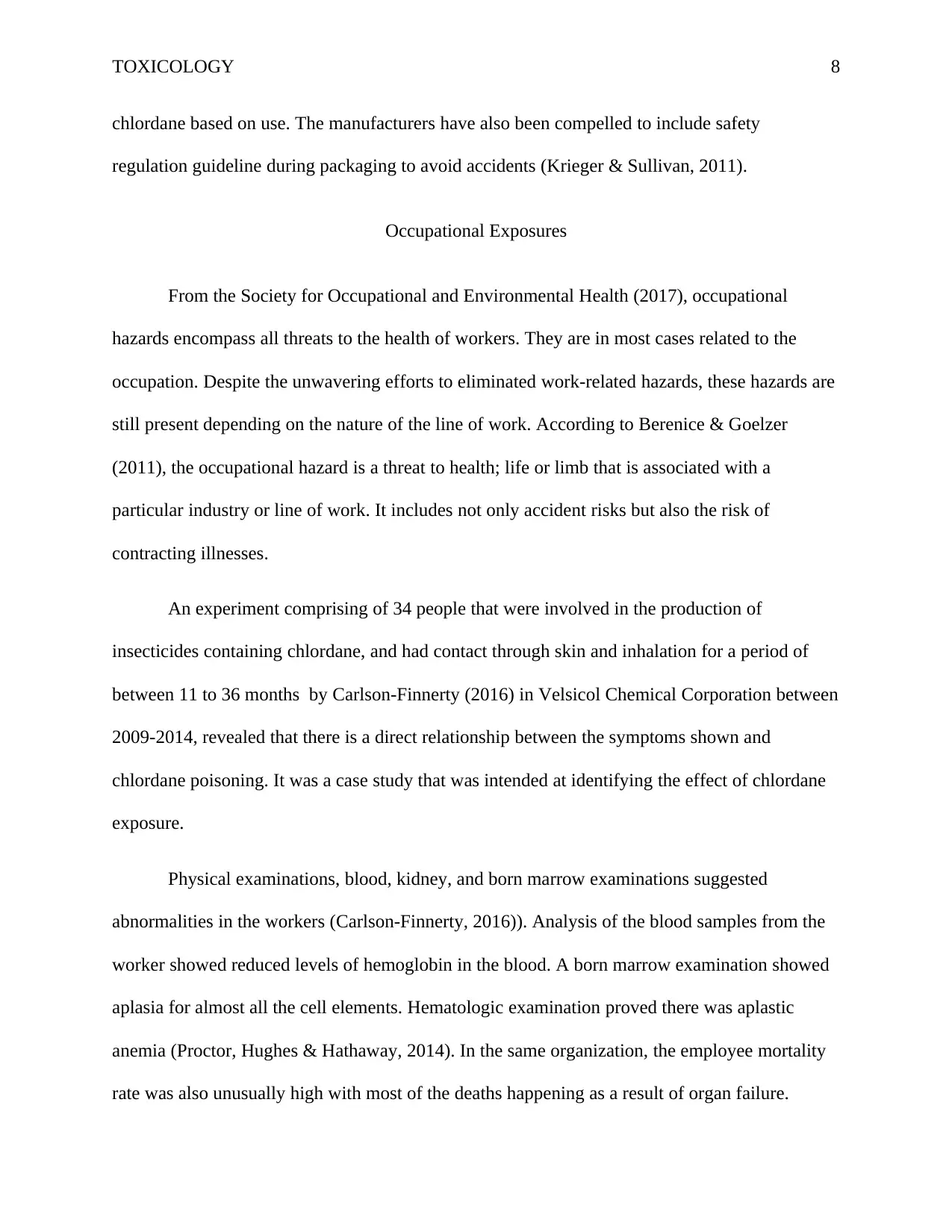
TOXICOLOGY 8
chlordane based on use. The manufacturers have also been compelled to include safety
regulation guideline during packaging to avoid accidents (Krieger & Sullivan, 2011).
Occupational Exposures
From the Society for Occupational and Environmental Health (2017), occupational
hazards encompass all threats to the health of workers. They are in most cases related to the
occupation. Despite the unwavering efforts to eliminated work-related hazards, these hazards are
still present depending on the nature of the line of work. According to Berenice & Goelzer
(2011), the occupational hazard is a threat to health; life or limb that is associated with a
particular industry or line of work. It includes not only accident risks but also the risk of
contracting illnesses.
An experiment comprising of 34 people that were involved in the production of
insecticides containing chlordane, and had contact through skin and inhalation for a period of
between 11 to 36 months by Carlson-Finnerty (2016) in Velsicol Chemical Corporation between
2009-2014, revealed that there is a direct relationship between the symptoms shown and
chlordane poisoning. It was a case study that was intended at identifying the effect of chlordane
exposure.
Physical examinations, blood, kidney, and born marrow examinations suggested
abnormalities in the workers (Carlson-Finnerty, 2016)). Analysis of the blood samples from the
worker showed reduced levels of hemoglobin in the blood. A born marrow examination showed
aplasia for almost all the cell elements. Hematologic examination proved there was aplastic
anemia (Proctor, Hughes & Hathaway, 2014). In the same organization, the employee mortality
rate was also unusually high with most of the deaths happening as a result of organ failure.
chlordane based on use. The manufacturers have also been compelled to include safety
regulation guideline during packaging to avoid accidents (Krieger & Sullivan, 2011).
Occupational Exposures
From the Society for Occupational and Environmental Health (2017), occupational
hazards encompass all threats to the health of workers. They are in most cases related to the
occupation. Despite the unwavering efforts to eliminated work-related hazards, these hazards are
still present depending on the nature of the line of work. According to Berenice & Goelzer
(2011), the occupational hazard is a threat to health; life or limb that is associated with a
particular industry or line of work. It includes not only accident risks but also the risk of
contracting illnesses.
An experiment comprising of 34 people that were involved in the production of
insecticides containing chlordane, and had contact through skin and inhalation for a period of
between 11 to 36 months by Carlson-Finnerty (2016) in Velsicol Chemical Corporation between
2009-2014, revealed that there is a direct relationship between the symptoms shown and
chlordane poisoning. It was a case study that was intended at identifying the effect of chlordane
exposure.
Physical examinations, blood, kidney, and born marrow examinations suggested
abnormalities in the workers (Carlson-Finnerty, 2016)). Analysis of the blood samples from the
worker showed reduced levels of hemoglobin in the blood. A born marrow examination showed
aplasia for almost all the cell elements. Hematologic examination proved there was aplastic
anemia (Proctor, Hughes & Hathaway, 2014). In the same organization, the employee mortality
rate was also unusually high with most of the deaths happening as a result of organ failure.
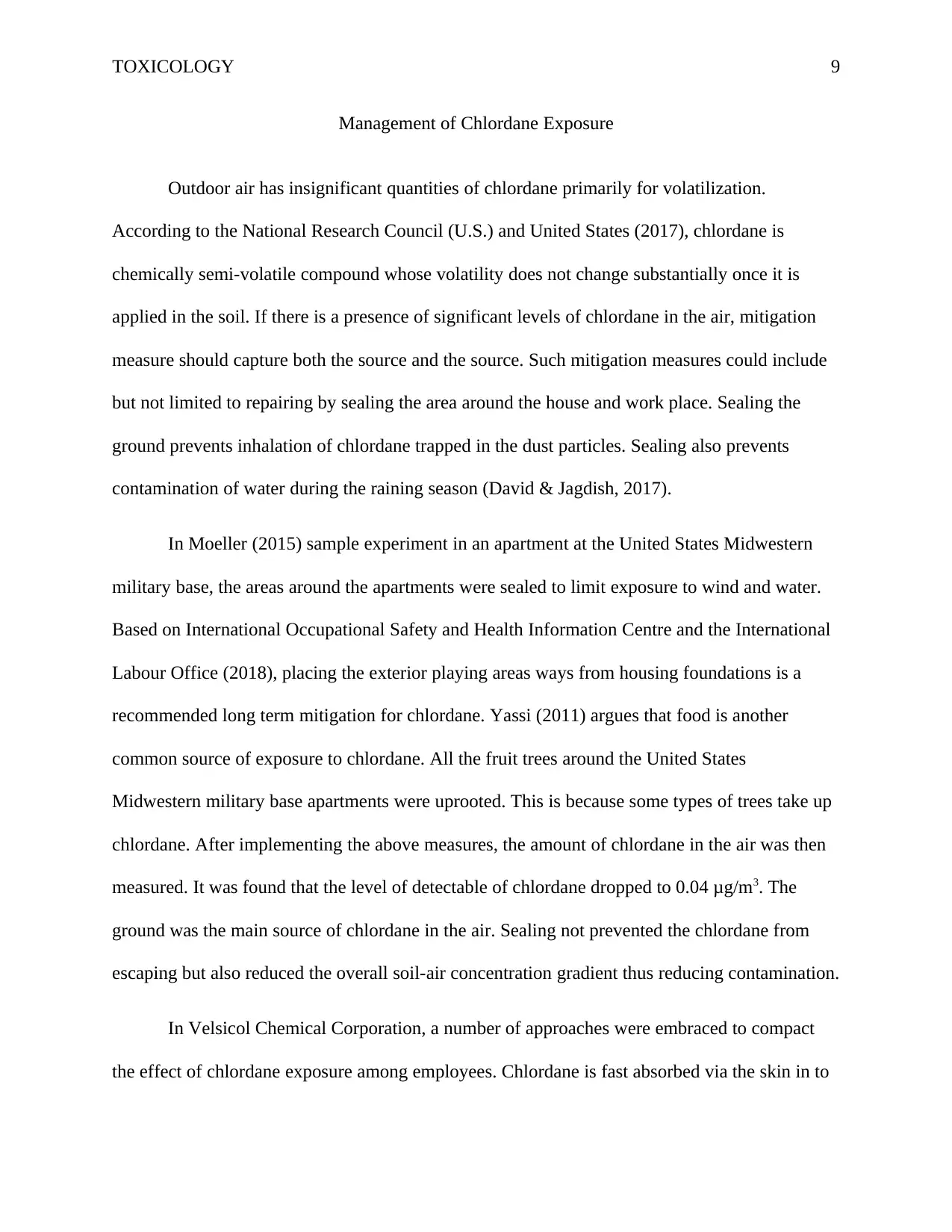
TOXICOLOGY 9
Management of Chlordane Exposure
Outdoor air has insignificant quantities of chlordane primarily for volatilization.
According to the National Research Council (U.S.) and United States (2017), chlordane is
chemically semi-volatile compound whose volatility does not change substantially once it is
applied in the soil. If there is a presence of significant levels of chlordane in the air, mitigation
measure should capture both the source and the source. Such mitigation measures could include
but not limited to repairing by sealing the area around the house and work place. Sealing the
ground prevents inhalation of chlordane trapped in the dust particles. Sealing also prevents
contamination of water during the raining season (David & Jagdish, 2017).
In Moeller (2015) sample experiment in an apartment at the United States Midwestern
military base, the areas around the apartments were sealed to limit exposure to wind and water.
Based on International Occupational Safety and Health Information Centre and the International
Labour Office (2018), placing the exterior playing areas ways from housing foundations is a
recommended long term mitigation for chlordane. Yassi (2011) argues that food is another
common source of exposure to chlordane. All the fruit trees around the United States
Midwestern military base apartments were uprooted. This is because some types of trees take up
chlordane. After implementing the above measures, the amount of chlordane in the air was then
measured. It was found that the level of detectable of chlordane dropped to 0.04 μg/m3. The
ground was the main source of chlordane in the air. Sealing not prevented the chlordane from
escaping but also reduced the overall soil-air concentration gradient thus reducing contamination.
In Velsicol Chemical Corporation, a number of approaches were embraced to compact
the effect of chlordane exposure among employees. Chlordane is fast absorbed via the skin in to
Management of Chlordane Exposure
Outdoor air has insignificant quantities of chlordane primarily for volatilization.
According to the National Research Council (U.S.) and United States (2017), chlordane is
chemically semi-volatile compound whose volatility does not change substantially once it is
applied in the soil. If there is a presence of significant levels of chlordane in the air, mitigation
measure should capture both the source and the source. Such mitigation measures could include
but not limited to repairing by sealing the area around the house and work place. Sealing the
ground prevents inhalation of chlordane trapped in the dust particles. Sealing also prevents
contamination of water during the raining season (David & Jagdish, 2017).
In Moeller (2015) sample experiment in an apartment at the United States Midwestern
military base, the areas around the apartments were sealed to limit exposure to wind and water.
Based on International Occupational Safety and Health Information Centre and the International
Labour Office (2018), placing the exterior playing areas ways from housing foundations is a
recommended long term mitigation for chlordane. Yassi (2011) argues that food is another
common source of exposure to chlordane. All the fruit trees around the United States
Midwestern military base apartments were uprooted. This is because some types of trees take up
chlordane. After implementing the above measures, the amount of chlordane in the air was then
measured. It was found that the level of detectable of chlordane dropped to 0.04 μg/m3. The
ground was the main source of chlordane in the air. Sealing not prevented the chlordane from
escaping but also reduced the overall soil-air concentration gradient thus reducing contamination.
In Velsicol Chemical Corporation, a number of approaches were embraced to compact
the effect of chlordane exposure among employees. Chlordane is fast absorbed via the skin in to
⊘ This is a preview!⊘
Do you want full access?
Subscribe today to unlock all pages.

Trusted by 1+ million students worldwide
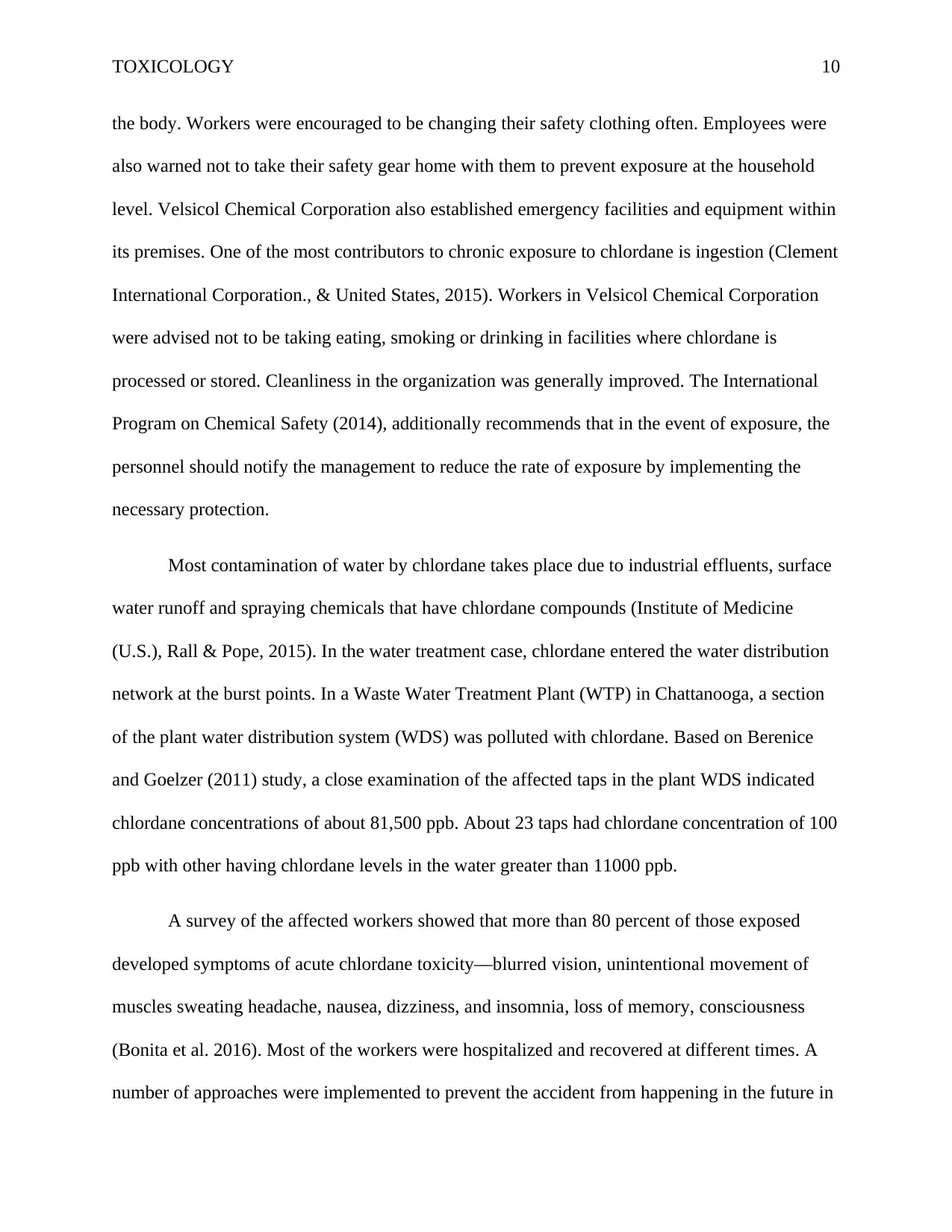
TOXICOLOGY 10
the body. Workers were encouraged to be changing their safety clothing often. Employees were
also warned not to take their safety gear home with them to prevent exposure at the household
level. Velsicol Chemical Corporation also established emergency facilities and equipment within
its premises. One of the most contributors to chronic exposure to chlordane is ingestion (Clement
International Corporation., & United States, 2015). Workers in Velsicol Chemical Corporation
were advised not to be taking eating, smoking or drinking in facilities where chlordane is
processed or stored. Cleanliness in the organization was generally improved. The International
Program on Chemical Safety (2014), additionally recommends that in the event of exposure, the
personnel should notify the management to reduce the rate of exposure by implementing the
necessary protection.
Most contamination of water by chlordane takes place due to industrial effluents, surface
water runoff and spraying chemicals that have chlordane compounds (Institute of Medicine
(U.S.), Rall & Pope, 2015). In the water treatment case, chlordane entered the water distribution
network at the burst points. In a Waste Water Treatment Plant (WTP) in Chattanooga, a section
of the plant water distribution system (WDS) was polluted with chlordane. Based on Berenice
and Goelzer (2011) study, a close examination of the affected taps in the plant WDS indicated
chlordane concentrations of about 81,500 ppb. About 23 taps had chlordane concentration of 100
ppb with other having chlordane levels in the water greater than 11000 ppb.
A survey of the affected workers showed that more than 80 percent of those exposed
developed symptoms of acute chlordane toxicity—blurred vision, unintentional movement of
muscles sweating headache, nausea, dizziness, and insomnia, loss of memory, consciousness
(Bonita et al. 2016). Most of the workers were hospitalized and recovered at different times. A
number of approaches were implemented to prevent the accident from happening in the future in
the body. Workers were encouraged to be changing their safety clothing often. Employees were
also warned not to take their safety gear home with them to prevent exposure at the household
level. Velsicol Chemical Corporation also established emergency facilities and equipment within
its premises. One of the most contributors to chronic exposure to chlordane is ingestion (Clement
International Corporation., & United States, 2015). Workers in Velsicol Chemical Corporation
were advised not to be taking eating, smoking or drinking in facilities where chlordane is
processed or stored. Cleanliness in the organization was generally improved. The International
Program on Chemical Safety (2014), additionally recommends that in the event of exposure, the
personnel should notify the management to reduce the rate of exposure by implementing the
necessary protection.
Most contamination of water by chlordane takes place due to industrial effluents, surface
water runoff and spraying chemicals that have chlordane compounds (Institute of Medicine
(U.S.), Rall & Pope, 2015). In the water treatment case, chlordane entered the water distribution
network at the burst points. In a Waste Water Treatment Plant (WTP) in Chattanooga, a section
of the plant water distribution system (WDS) was polluted with chlordane. Based on Berenice
and Goelzer (2011) study, a close examination of the affected taps in the plant WDS indicated
chlordane concentrations of about 81,500 ppb. About 23 taps had chlordane concentration of 100
ppb with other having chlordane levels in the water greater than 11000 ppb.
A survey of the affected workers showed that more than 80 percent of those exposed
developed symptoms of acute chlordane toxicity—blurred vision, unintentional movement of
muscles sweating headache, nausea, dizziness, and insomnia, loss of memory, consciousness
(Bonita et al. 2016). Most of the workers were hospitalized and recovered at different times. A
number of approaches were implemented to prevent the accident from happening in the future in
Paraphrase This Document
Need a fresh take? Get an instant paraphrase of this document with our AI Paraphraser
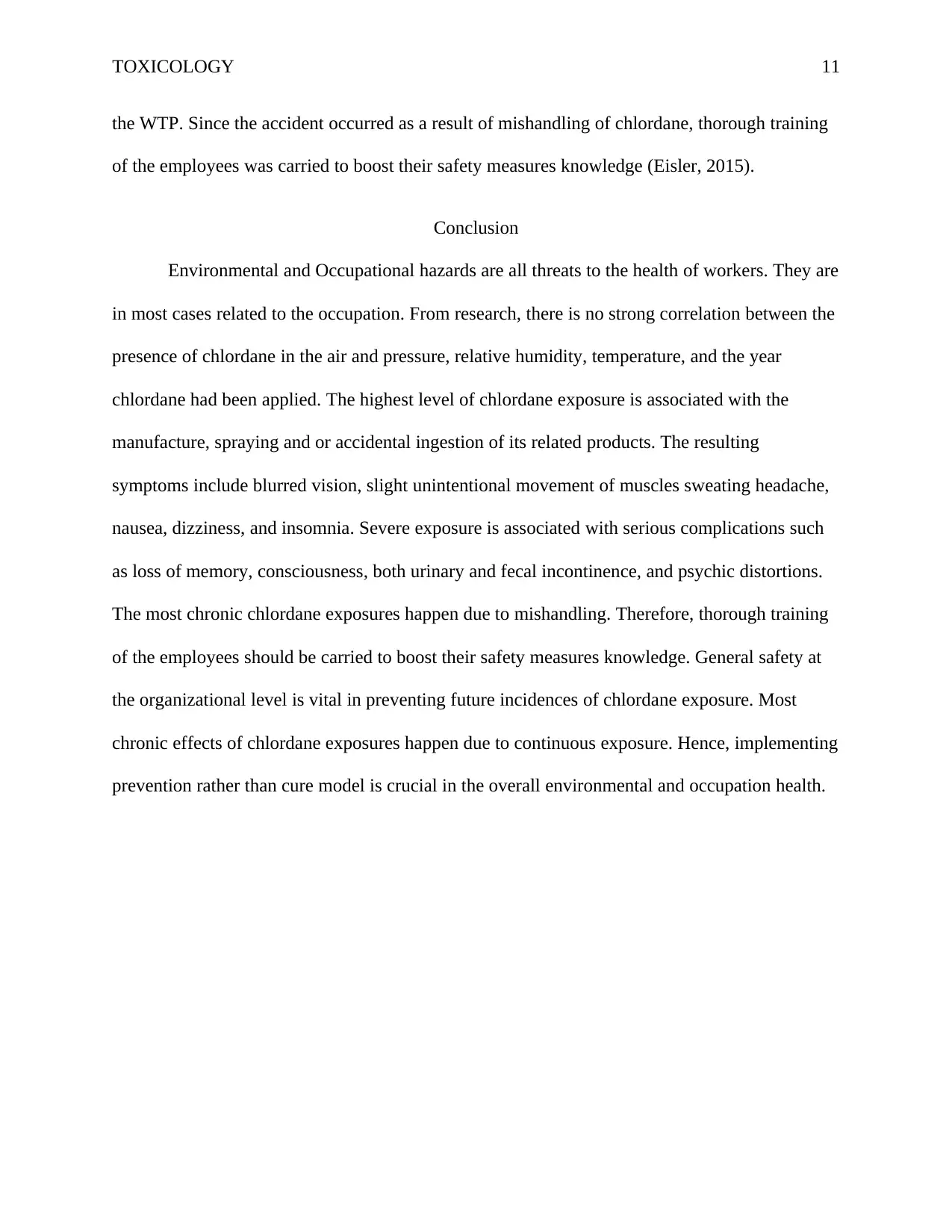
TOXICOLOGY 11
the WTP. Since the accident occurred as a result of mishandling of chlordane, thorough training
of the employees was carried to boost their safety measures knowledge (Eisler, 2015).
Conclusion
Environmental and Occupational hazards are all threats to the health of workers. They are
in most cases related to the occupation. From research, there is no strong correlation between the
presence of chlordane in the air and pressure, relative humidity, temperature, and the year
chlordane had been applied. The highest level of chlordane exposure is associated with the
manufacture, spraying and or accidental ingestion of its related products. The resulting
symptoms include blurred vision, slight unintentional movement of muscles sweating headache,
nausea, dizziness, and insomnia. Severe exposure is associated with serious complications such
as loss of memory, consciousness, both urinary and fecal incontinence, and psychic distortions.
The most chronic chlordane exposures happen due to mishandling. Therefore, thorough training
of the employees should be carried to boost their safety measures knowledge. General safety at
the organizational level is vital in preventing future incidences of chlordane exposure. Most
chronic effects of chlordane exposures happen due to continuous exposure. Hence, implementing
prevention rather than cure model is crucial in the overall environmental and occupation health.
the WTP. Since the accident occurred as a result of mishandling of chlordane, thorough training
of the employees was carried to boost their safety measures knowledge (Eisler, 2015).
Conclusion
Environmental and Occupational hazards are all threats to the health of workers. They are
in most cases related to the occupation. From research, there is no strong correlation between the
presence of chlordane in the air and pressure, relative humidity, temperature, and the year
chlordane had been applied. The highest level of chlordane exposure is associated with the
manufacture, spraying and or accidental ingestion of its related products. The resulting
symptoms include blurred vision, slight unintentional movement of muscles sweating headache,
nausea, dizziness, and insomnia. Severe exposure is associated with serious complications such
as loss of memory, consciousness, both urinary and fecal incontinence, and psychic distortions.
The most chronic chlordane exposures happen due to mishandling. Therefore, thorough training
of the employees should be carried to boost their safety measures knowledge. General safety at
the organizational level is vital in preventing future incidences of chlordane exposure. Most
chronic effects of chlordane exposures happen due to continuous exposure. Hence, implementing
prevention rather than cure model is crucial in the overall environmental and occupation health.
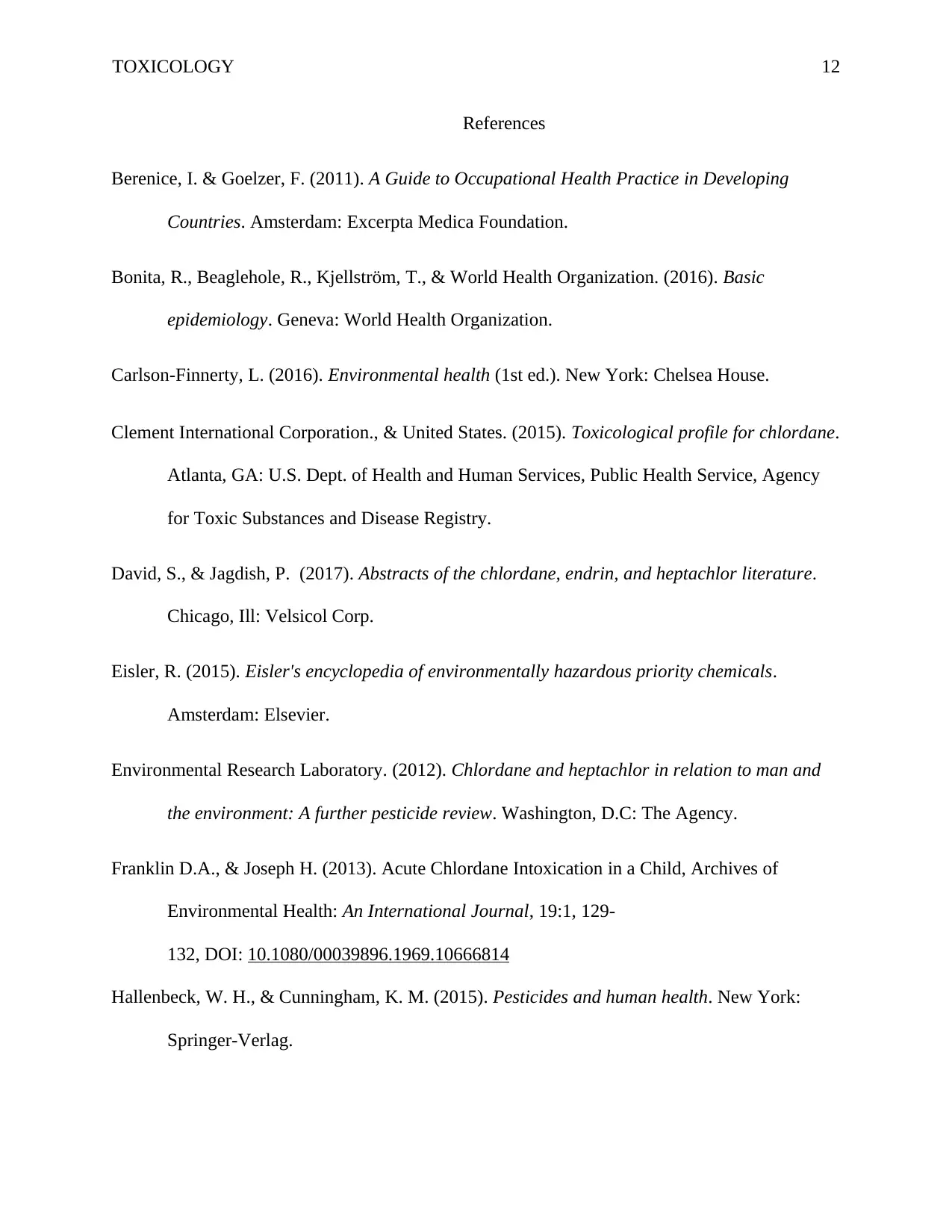
TOXICOLOGY 12
References
Berenice, I. & Goelzer, F. (2011). A Guide to Occupational Health Practice in Developing
Countries. Amsterdam: Excerpta Medica Foundation.
Bonita, R., Beaglehole, R., Kjellström, T., & World Health Organization. (2016). Basic
epidemiology. Geneva: World Health Organization.
Carlson-Finnerty, L. (2016). Environmental health (1st ed.). New York: Chelsea House.
Clement International Corporation., & United States. (2015). Toxicological profile for chlordane.
Atlanta, GA: U.S. Dept. of Health and Human Services, Public Health Service, Agency
for Toxic Substances and Disease Registry.
David, S., & Jagdish, P. (2017). Abstracts of the chlordane, endrin, and heptachlor literature.
Chicago, Ill: Velsicol Corp.
Eisler, R. (2015). Eisler's encyclopedia of environmentally hazardous priority chemicals.
Amsterdam: Elsevier.
Environmental Research Laboratory. (2012). Chlordane and heptachlor in relation to man and
the environment: A further pesticide review. Washington, D.C: The Agency.
Franklin D.A., & Joseph H. (2013). Acute Chlordane Intoxication in a Child, Archives of
Environmental Health: An International Journal, 19:1, 129-
132, DOI: 10.1080/00039896.1969.10666814
Hallenbeck, W. H., & Cunningham, K. M. (2015). Pesticides and human health. New York:
Springer-Verlag.
References
Berenice, I. & Goelzer, F. (2011). A Guide to Occupational Health Practice in Developing
Countries. Amsterdam: Excerpta Medica Foundation.
Bonita, R., Beaglehole, R., Kjellström, T., & World Health Organization. (2016). Basic
epidemiology. Geneva: World Health Organization.
Carlson-Finnerty, L. (2016). Environmental health (1st ed.). New York: Chelsea House.
Clement International Corporation., & United States. (2015). Toxicological profile for chlordane.
Atlanta, GA: U.S. Dept. of Health and Human Services, Public Health Service, Agency
for Toxic Substances and Disease Registry.
David, S., & Jagdish, P. (2017). Abstracts of the chlordane, endrin, and heptachlor literature.
Chicago, Ill: Velsicol Corp.
Eisler, R. (2015). Eisler's encyclopedia of environmentally hazardous priority chemicals.
Amsterdam: Elsevier.
Environmental Research Laboratory. (2012). Chlordane and heptachlor in relation to man and
the environment: A further pesticide review. Washington, D.C: The Agency.
Franklin D.A., & Joseph H. (2013). Acute Chlordane Intoxication in a Child, Archives of
Environmental Health: An International Journal, 19:1, 129-
132, DOI: 10.1080/00039896.1969.10666814
Hallenbeck, W. H., & Cunningham, K. M. (2015). Pesticides and human health. New York:
Springer-Verlag.
⊘ This is a preview!⊘
Do you want full access?
Subscribe today to unlock all pages.

Trusted by 1+ million students worldwide
1 out of 14
Your All-in-One AI-Powered Toolkit for Academic Success.
+13062052269
info@desklib.com
Available 24*7 on WhatsApp / Email
![[object Object]](/_next/static/media/star-bottom.7253800d.svg)
Unlock your academic potential
Copyright © 2020–2025 A2Z Services. All Rights Reserved. Developed and managed by ZUCOL.
